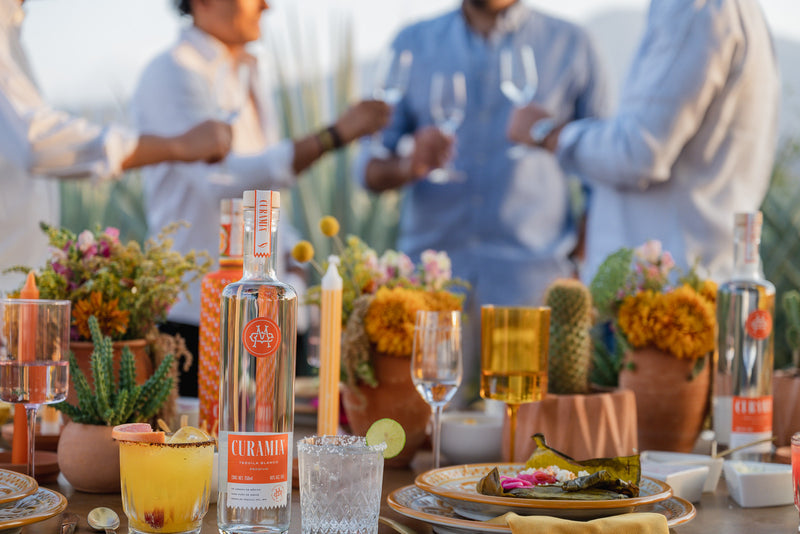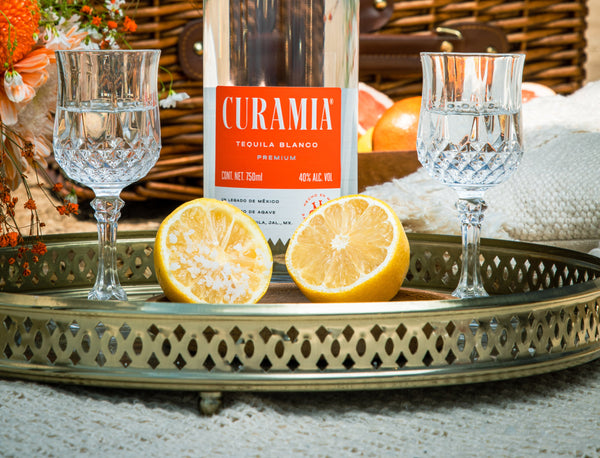A renewed interest in tequila has the world wondering where this infamous lime partner has been all this time. Well, amigos, it’s been around for quite a while. A true piece of Mexican heritage, tequila is not just a spirit. It’s actually intellectual property owned by the Mexican government!
And it’s made a splash in cocktails it previously had no business in—like the Old Fashioned. Given tequila's rise in popularity over whiskey, it’s overtaking the world one complex cocktail at a time. Let’s review all of the different types of tequila so you can impress mixologists at the bar and friends at dinner alike.
A Brief Tequila History
Tequila’s production dates back to between 1000 B.C. and 200 A.D. when the Aztecs first fermented agave. At this time, the fermented drink was called pulque and used the sap of the agave plant. Then, as the Spanish invaded the area, they began distilling agave with mud as a substitution for their beloved brandy. This primitive drink is what we now call mezcal.
Fast forward to the 1700s, and modern tequila is officially on the market, thanks to the Cuervo family (yes, that Cuervo family), who began commercially distilling tequila in 1758. As legend has it, Don Cenobio Sauza determined blue agave was the best plant variety for making tequila, and so it became the favorite of distillers all over the country.
Following tequila’s commercial rise to fame, the margarita was invented in 1936. Fun fact: In the bar it was created, it was actually named the Tequila Daisy!
In 1974, the Mexican government declared ownership of the term “tequila” as its intellectual property. This move made it a requirement for tequila to be made and aged in designated areas of Mexico only, making it illegal for tequila to be made and marketed as such in other countries.
And the rest, well, has brought us here!
The Tequila Production Process
Harvesting Agave
All types of tequila begin the same way—with the harvesting of the agave plant. Blue agave used for tequila is fully grown in six years. It’s harvested using a tool called a coa de jima, which splices the agave leaves and separates the piña (the core) from the plant. The piña looks just like what it sounds like—a pineapple. True to our Mexican roots, all of the agave harvested for Curamia Tequila is grown in Jalisco, Mexico.
Fermenting and Distilling Agave
Once the piñas have been extracted from the plant, they’re cooked. Traditionally, ovens are used, but modern-day distillers also use diffusers and autoclaves to cook faster. Curamia Tequila uses a water-steaming process that extracts more sugar from each agave plant for a smoother yet traditional taste.
Once the piñas are cooked, they’re shredded into juice, and added to yeast and water. The combination of the sugars and the yeast ferments into alcohol, and the liquid is distilled twice to purify the alcohol, making it drinkable.
Aging the Alcohol
Once the alcohol has finished the distillation process, it’s a clear liquid. This is where the magic of the different types of tequila takes place. Clear tequila is taken straight to the bottling process. This is called blanco tequila.
However, some tequila is stored in barrels and aged for a certain length of time. This aging process makes different types of tequila, such as resposado or añejo, which each have a different flavor profile. (More on that in a second.) Each of the different tequilas has a different maturation length.
Different Types of Tequila You Need to Know
Now that you know how tequila is made, the different types of tequila will make much more sense. There are six different tequilas: blanco, joven, reposado, añejo, extra añejo, and cristalino. Each of these grades of tequila is created using a different maturation length.
Blanco Tequila (Silver)
Blanco tequila (sometimes called silver tequila) is the clearest, least aged, and most pure type of tequila. Though technically, it can be aged up to two months, most blanco tequilas are bottled immediately after distillation.
You’ll know blanco tequila when it hits your tastebuds because of its strong, sharp bite. It has notes of citrus, grass, and pepper. You’re also probably familiar with this type of tequila in the margarita or the Paloma. Citrus flavors pair well with blanco tequila in cocktail recipes, though a shot finished with a taste of lime is equally as enjoyable.
Blanco tequila is the base for all the other types of tequila.
Joven Tequila (Gold)
Joven tequila (sometimes referred to as gold tequila) is a bit under the radar compared to its blanco and aged siblings. In fact, joven tequila is a blend of the two—primarily blanco tequila mixed with a small amount of aged tequila that shares characteristics with scotch.
Like the other aged varieties, it gets its name from the aging process; joven means “young.” Joven tequila can be mixto tequilas in disguise. Be sure to read the label carefully to see if additives are included or if it’s a pure 100% blue agave tequila.
Reposado Tequila (Rested)
Blanco tequila aged for two months to a year is called reposado tequila. The word reposado means “rested,” and that’s just what we love about it. Reposado is aged in wooden (typically oak) barrels, which causes reposado tequila to have a warmer taste and develop a light golden color.
When comparing the taste of reposado tequila vs blanco tequila, reposado tastes smoother with notes of spice, vanilla, or caramel. With reposado, you’ll get a flavor reminiscent of whiskey or cognac, meaning a toastier, more caramelized flavor with spicy and sweet aromatics. These warm flavors provide a richer experience that pairs well with coconut.
Añejo Tequila (Aged)
Añejo tequila is tequila that has been aged for one to three years. The length of time spent in oak barrels gives this tequila a dark amber color with a rich, complex flavor with notes of vanilla, dried fruit, chocolate, and baking spices. When comparing reposado vs. añejo, añejo is much richer and more complex.
It’s typically sipped neat or on the rocks, but it is also suitable for replacing whiskey in cocktails, like an Old Fashioned. The añejo flavor plays well with chocolate or dried fruit notes in a cocktail and pairs well with queso, honey-glazed meats, or spicy foods on the menu.
Añejo translates to “old,” though it’s not the oldest of all the aged types of tequila.
Extra Añejo Tequila (Ultra-Aged)
Extra añejo tequila, which means “extra old,” has been aged for at least three years, though many have been aged for more than ten years. Ironically, despite its name, extra añejo tequila has only been an official grade of tequila since 2006, though it’s considered the pinnacle of aged tequilas.
With a longer aging process comes an even more intense and exquisite flavor profile, with notes reminiscent of cognac or whiskey and intense flavors of caramel, vanilla, and baking spices. Typically, the flavor profile and warmth of the oak influence how extra añejo tequila is enjoyed; it’s typically sipped on its own.
Cristalino Tequila
Cristalino tequila is relatively new and has yet to be standardized by the CRT. In fact, the first appearance of cristalino tequila was in 2011, making it less than 15 years old. The name cristalino translates to “crystalline.”
Though cristalino tequilas are aged in oak, they have little to no color thanks to a charcoal-filtering process that removes their natural colors and oak flavor profiles. The final product is a tequila that looks like a blanco but has the flavor and personality of an aged tequila.
A Note on Tequila Additives
By law, according to the CRT (which regulates tequila production), blanco tequila can not contain any additives, though approximately 70% of different tequilas on the market contain additives. Aged tequila can include up to 1% undisclosed additives and still be legally considered 100% agave, though any tequila with more additives than this is called mixto tequila.
Additives are included in different tequilas for various reasons: coloring, flavoring, sweetening, and aromatics. However, traditional and pure (AKA free of additives) tequila is generally considered the best way to drink it, as it gives you the purest tasting experience. Curamia Tequila uses zero additives in each of our delicious grades of tequila, staying true to our authentic roots.
Proper Ways to Taste and Enjoy Different Types of Tequila
Tasting Techniques for Different Types of Tequila
Because of the different types of tequila, it’s an incredibly diverse spirit. It can be sipped, shaken in a cocktail, or served on the rocks—and all are equally enjoyable. When tasting different types of tequila, start from light to dark. This will allow you to experience each of the distinct flavor and aroma profiles fully.
To enjoy your tasting experience, swirl the tequila in the glass. Swirling will release the aromas into the glass. To experience the unique aromas, raise the glass to your nose and sniff it. Next, it’s time to get a taste. Take a small sip, let it sit in your mouth for a few seconds, and coat your tongue. Swallow the liquid and exhale through your mouth to release the bite of the tequila.
Glassware for Different Tequilas
The proper tequila glassware depends on how you plan to enjoy your tequila, whether as a shot, sip, or cocktail.
If you plan to sip tequila for a tequila tasting, use a proper tequila snifter. If you forget the snifters, you can also use a champagne flute! Consuming tequila in such a classy way will also ease your mind into how tequila was meant to be—slowly with appreciation.
If you’re making a tequila cocktail, choose the proper glassware for the drink. Margarita glasses were made just for those lime juice treats, while cocktail tumblers are excellent for enjoying it on the rocks. Specialty mixed drinks are enjoyed in unique cocktail glasses, such as hurricane glasses.
Tequila Food Pairings
Obviously, tequila is the perfect match for Mexican food, like tacos, fajitas, or burritos. But the diverse grades of tequila open it up to an array of different food pairings for those who want a different menu.
Fish, raw or grilled, is an excellent match for tequila, especially when well-seasoned in garlic or chili. Equally extravagant as the main dish, rich meats, like juicy steak or pork chops, taste exquisite next to a reposado or añejo, respectively.
On the side or as an appetizer, vegetables, and charcuterie complete the tequila tasting menu. Incorporate charred tomatillos or fresh zucchini with your meat. Charcuterie should include chocolate, salty cheeses, and nuts for the perfect tequila plating.
Tequila’s Influence on Cocktails
The most popular tequila-based cocktails include the famous Margarita, the Paloma, and the Tequila Sunrise. These cocktails are traditionally made with blanco tequila, though there are spectacular cocktail recipes made from all the different types of tequila.
For example, a popular twist on the classic Margarita is the Cadillac Margarita, a more decadent version made with reposado or añejo tequila. Similarly, the traditional Old Fashioned can be spiced up a notch by replacing the whiskey with añejo tequila.
In cocktails, tequila pairs well with citrus and freshly squeezed juices. Hence, the margarita is so famous—it’s just the perfect pairing. To perfect your margarita, you don’t need much. A simple shake of ice, tequila, fresh lime juice, and agave syrup will give you an unadulterated, purely authentic treat that packs a punch without heavy artificial sugars or unneeded ingredients.
Types of Tequila FAQ
What are the basic types of tequila?
The basic, traditional types of tequila are blanco, reposado, añejo, and extra añejo. Newer varieties of the different tequilas include joven and cristalino. Each of the grades of tequila is classified by the time spent in the aging process.
What type of tequila is the smoothest?
As tequila ages, it gets smoother. Therefore, of the different types of tequila, reposado is smoother than blanco, añejo is smoother than reposado, and so on.
Is Añejo or Reposado better?
Reposado vs. añejo is a common match-up. Unfortunately, there’s no clear winner in this debate. Regarding reposado tequila vs. añejo tequila, it all depends on your personal taste.
If you enjoy a softer tequila, you may like reposado better. If you want a robust and complex tequila, añejo tequila is best for you. If you’ve run out of whiskey for your favorite cocktail, añejo is also a good substitute.
Both are enjoyed sipped neat or in cocktails; however, reposado is best used in citrus-forward drinks, while añejo shines with a deeper, richer mixer.
Tequila is rising in popularity, and we’re not mad about it. It’s about time the world experiences what we’ve known and loved about tequila for generations. It’s more than a college party drink; it’s meant to be enjoyed surrounded by friends and family. Sipped to celebrate and shaken to enjoy, tequila brings us together.
No matter what types of tequila you gravitate towards, you’ll taste the difference in Curamia Tequila. Our five different tequilas are additive-free, with a smoother taste from a more sustainable distilling process. We don’t modify our tequila’s flavors; we like pure, authentic Jalisco juice right from the source.
The tequila exploration journey is an exciting, tasteful experience. Find out which is your favorite, and you may just discover you like sipping the stuff more than you like it paired with a salted rim!
Stock up on your next tasting with Curamia Tequilas. Find bottles in stores near you, or ship them all right to your door for a hassle-free shopping experience without the weight.




